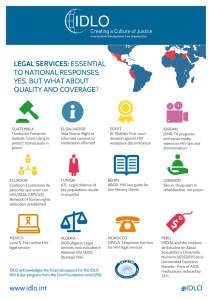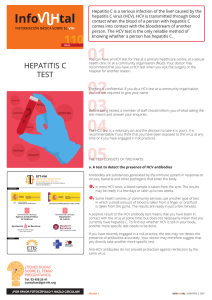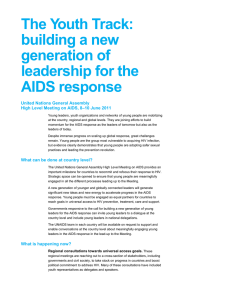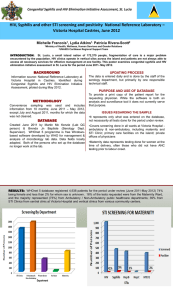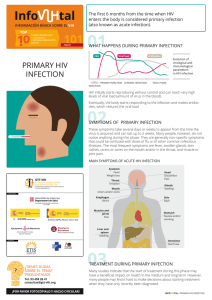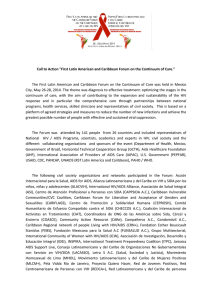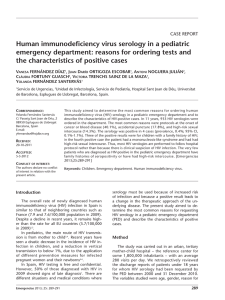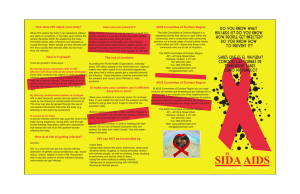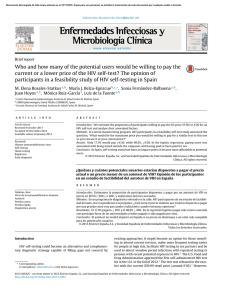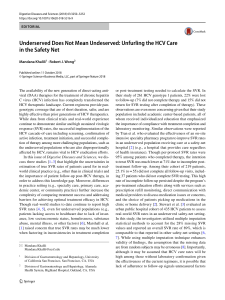Factors associated with hepatitis C seropositivity in people living
Anuncio
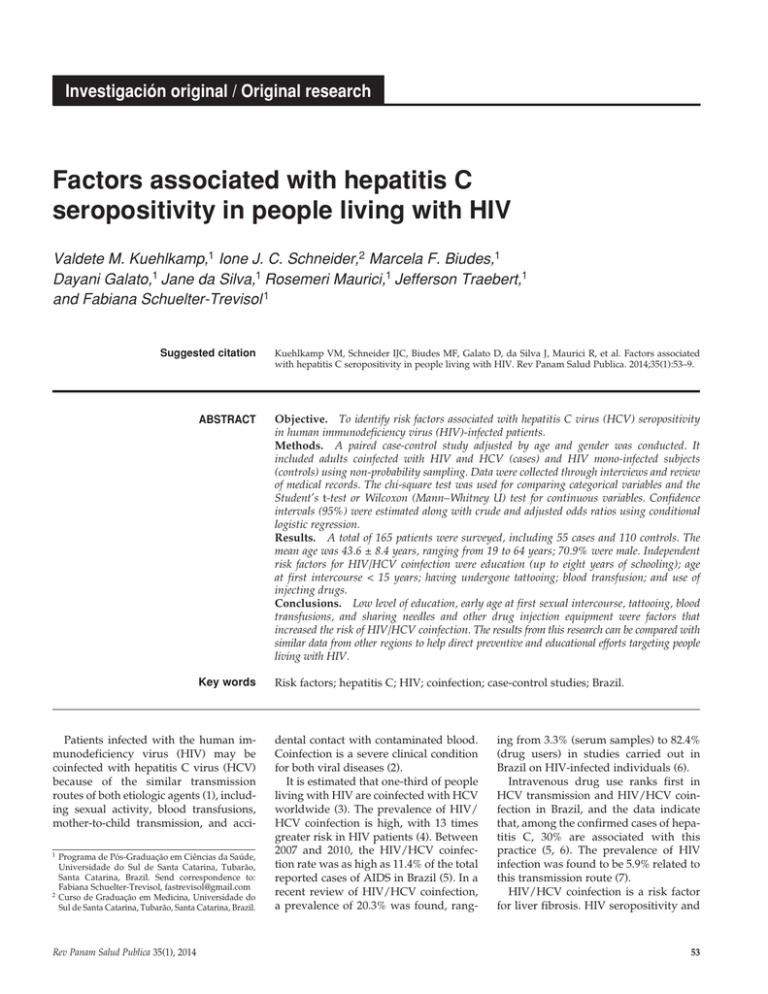
Investigación original / Original research Factors associated with hepatitis C seropositivity in people living with HIV Valdete M. Kuehlkamp,1 Ione J. C. Schneider,2 Marcela F. Biudes,1 Dayani Galato,1 Jane da Silva,1 Rosemeri Maurici,1 Jefferson Traebert,1 and Fabiana Schuelter-Trevisol 1 Suggested citation Kuehlkamp VM, Schneider IJC, Biudes MF, Galato D, da Silva J, Maurici R, et al. Factors associated with hepatitis C seropositivity in people living with HIV. Rev Panam Salud Publica. 2014;35(1):53–9. abstract Objective. To identify risk factors associated with hepatitis C virus (HCV) seropositivity in human immunodeficiency virus (HIV)-infected patients. Methods. A paired case-control study adjusted by age and gender was conducted. It included adults coinfected with HIV and HCV (cases) and HIV mono-infected subjects (controls) using non-probability sampling. Data were collected through interviews and review of medical records. The chi-square test was used for comparing categorical variables and the Student’s t-test or Wilcoxon (Mann–Whitney U) test for continuous variables. Confidence intervals (95%) were estimated along with crude and adjusted odds ratios using conditional logistic regression. Results. A total of 165 patients were surveyed, including 55 cases and 110 controls. The mean age was 43.6 ± 8.4 years, ranging from 19 to 64 years; 70.9% were male. Independent risk factors for HIV/HCV coinfection were education (up to eight years of schooling); age at first intercourse < 15 years; having undergone tattooing; blood transfusion; and use of injecting drugs. Conclusions. Low level of education, early age at first sexual intercourse, tattooing, blood transfusions, and sharing needles and other drug injection equipment were factors that increased the risk of HIV/HCV coinfection. The results from this research can be compared with similar data from other regions to help direct preventive and educational efforts targeting people living with HIV. Key words Risk factors; hepatitis C; HIV; coinfection; case-control studies; Brazil. Patients infected with the human immunodeficiency virus (HIV) may be coinfected with hepatitis C virus (HCV) because of the similar transmission routes of both etiologic agents (1), including sexual activity, blood transfusions, mother-to-child transmission, and acci1 Programa de Pós-Graduação em Ciências da Saúde, Universidade do Sul de Santa Catarina, Tubarão, Santa Catarina, Brazil. Send correspondence to: Fabiana Schuelter-Trevisol, fastrevisol@gmail.com 2Curso de Graduação em Medicina, Universidade do Sul de Santa Catarina, Tubarão, Santa Catarina, Brazil. Rev Panam Salud Publica 35(1), 2014 dental contact with contaminated blood. Coinfection is a severe clinical condition for both viral diseases (2). It is estimated that one-third of people living with HIV are coinfected with HCV worldwide (3). The prevalence of HIV/ HCV coinfection is high, with 13 times greater risk in HIV patients (4). Between 2007 and 2010, the HIV/HCV coinfection rate was as high as 11.4% of the total reported cases of AIDS in Brazil (5). In a recent review of HIV/HCV coinfection, a prevalence of 20.3% was found, rang- ing from 3.3% (serum samples) to 82.4% (drug users) in studies carried out in Brazil on HIV-infected individuals (6). Intravenous drug use ranks first in HCV transmission and HIV/HCV coinfection in Brazil, and the data indicate that, among the confirmed cases of hepatitis C, 30% are associated with this practice (5, 6). The prevalence of HIV infection was found to be 5.9% related to this transmission route (7). HIV/HCV coinfection is a risk factor for liver fibrosis. HIV seropositivity and 53 Original research Kuehlkamp et al. • Factors associated with hepatitis C seropositivity in people living with HIV low CD4+3 lymphocyte count seem to accelerate this process (8, 9). Similarly, HCV infection has been shown to be associated with more rapid progression to AIDS (10). HIV/HCV coinfection is a leading cause of morbidity and mortality worldwide. The complexity of the data that must be analyzed to determine the risk factors associated with HIV/HCV coinfection provides some indication of the obstacles faced by managers and health care professionals in control and prevention of these diseases. The current study aimed to contribute to these efforts by identifying risk factors associated with hepatitis C seropositivity in people living with HIV. The results from this research can be compared with similar data from other regions to help direct preventive and educational efforts targeting people living with HIV. in the study by the research or medical team were excluded from the study. HIV/HCV-coinfected patients were considered cases, and HIV–monoinfected persons were considered controls. The diagnosis of HIV infection was defined by laboratory evidence with the use of two screening tests in different serum samples and a confirmatory test. The diagnosis of HCV infection was defined by seropositivity to anti-HCV test. In this context, the controls should be positive for anti-HIV antibodies and negative for HCV (anti-HCV negative). Pairing was performed by coupling one individual (case) of the same gender and age with two individuals (control) up to the limit of a three-year age difference. Patients who signed the consent form were invited to participate in the study and were interviewed individually in a reserved room. Patient identification was excluded from the data collection tool, and the identities of the subjects were kept confidential and anonymous. The data collection instrument consisted of demographic and socioeconomic variables (gender, age, ethnicity, education level, and household income); sexual behavioral variables (age at first intercourse, sexual orientation, number of lifetime sexual partners, and sex without using a condom); personal and lifestyle behavior variables (tattooing, sharing personal items such as toothbrushes, razor blades, or nail clippers, and alcohol consumption); and morbidities and drug use (history of blood transfusions, intravenous or inhaled drugs such as cocaine and crack, exposure to medical MATERIALS AND METHODS The current research was a case-control study nested within a cross-sectional study examining prevalent cases of HIV infection. The authors surveyed HIV-infected individuals treated at specialized outpatient clinics in three cities in Santa Catarina State in Southern Brazil between October 2011 and August 2012. Injecting drug use was taken into account to determine the sample size, considering a prevalence of HCV infection in HIV-infected persons of 30% among cases (5) and 5.9% among controls (7), with a 95% confidence interval (CI), for a power value of 80%. This resulted in 48 cases and 96 controls at a 1:2 ratio, with a minimum sample size of 144 subjects for the study. A 10% addition was made to the total sample to compensate for losses. OpenEpi software version 2.3.1 (Open Source Epidemiologic Statistics for Public Health, www.openepi.com) was used to calculate the sample size. The study sample included male and female patients aged 18 years and older with a laboratory diagnosis of HIV infection who were treated at the outpatient clinics for at least four months and agreed to participate in the study by signing a consent form. Individuals without serological tests for hepatitis C and/or deemed unable to participate 3Type of white blood cells that are measured to assess HIV progression. 54 procedures such as endoscopy, surgery, exposure to contaminated sharps, and injections done by unlicensed persons). In addition, a documentary analysis of medical records was performed to collect clinical data and laboratory test results. The collected data were entered into EpiData software version 3.1 (EpiData Association, Odense, Denmark) and analyzed using the Statistical Product and Service Solutions (SPSS) for Windows version 19 (IBM SPSS Statistics, Chicago, Illinois, USA). Microsoft Office Excel 2007 (Microsoft Corporation, Redmond, WA, USA) was used to achieve age- and gender-matching manually. The variables were described as measures of central tendency and dispersion in the case of continuous variables. Categorical variables were described as absolute numbers and proportions. The nonparametric Wilcoxon (Mann–Whitney U) test was used in the case of variables with non-normal distribution. Crude and adjusted logistic regression analyses were performed to test the independence of association between the outcome (HIV/HCV coinfection) and the explanatory variables and estimate the odds ratios (ORs) and respective 95% CIs using Stata SE version 9.0 (StataCorp LP, College Station, Texas, USA). Variables that showed P < 0.20 in the chi-square test were included in the adjusted analysis in blocks, according to the following order: socio-demographic data, sexual behavior, lifestyle behavior, morbidities, and drug use (11), as shown in Figure 1. FIGURE 1. Hierarchical model for selection of confounding variables associated with HIV/ hepatitis C virus coinfection among HIV-infected patients at outpatient clinics in three cities in Santa Catarina State, Brazil, October 2011–August 2012 1st LEVEL Demographic characteristics Gender Age Skin color Socioeconomic characteristics Education Household income 2nd LEVEL Sexual behavior Lifestyle behavior Morbidities and drug use First sexual intercourse Sexual orientation Number of lifetime sexual partners Condom use during sex Tattooing Sharing personal hygiene objects Alcohol consumption History of blood transfusion Injecting drug use Cocaine use Crack use OUTCOME HIV/HCV coinfection Rev Panam Salud Publica 35(1), 2014 Kuehlkamp et al. • Factors associated with hepatitis C seropositivity in people living with HIV The first block of the model included variables with P < 0.05. The second block included variables with P < 0.20. Variables with P < 0.05 in this block were considered significant, and the variables of the previous block were maintained, even with P > 0.05. This procedure was repeated for the third, fourth, and fifth blocks. This study was approved by the Research Ethics Committee of the University of Southern Santa Catarina (Santa Catarina State, Brazil) under registration number 11.060.4.01.III. RESULTS In total, 165 HIV-infected individuals were studied, of whom 55 were considered cases (HIV/HCV-coinfected) and 110 controls (HIV–mono-infected), paired by age and gender. The mean age of the surveyed subjects was 43.6 (standard deviation (SD) = 8.4) years, ranging from 19 to 64 years; 70.9% were male. The majority (79%) of respondents lived with relatives, 18% lived alone, and the remainder lived with friends or in institutions. Household income and the number of lifetime sexual partners showed an asymmetric distribution. With regard to the comparison between medians, it was found that cases had lower household income (P = 0.011) and a higher number of sexual partners (P = 0.047) than controls. Table 1 shows the distribution of variables between the groups and the results of univariate and multivariate analysis. Univariate analysis of factors associated with HIV/HCV coinfection Education level showed a statistically significant difference (P = 0.011) in the comparison between groups. There was a predominance of poor education in both groups, but cases had a higher percentage of individuals with eight years of schooling or less. Cases had a higher percentage of non-whites in the sample composition and lower income, but without statistical significance (P = 0.060). With respect to personal behavioral aspects, early first sexual intercourse (P = 0.005); sexual orientation (being gay, lesbian, or bisexual) (P = 0.045); tattooing Rev Panam Salud Publica 35(1), 2014 Original research TABLE 1. Crude/adjusted odds ratios (ORs)a for socio-demographic variables, sexual/ lifestyle behavior, morbidity, and drug use associated with HIV/hepatitis C virus coinfection among HIV-infected patients at outpatient clinics in three cities in Santa Catarina State, Brazil, October 2011–August 2012 Variable Socio-demographic Skin color White Non-white Education (in years) 0–8 ≥9 Household income (R$c) 0.00–1 300 00 > 1 300 00 Sexual behavior First intercourse (age in years) ≤ 15 > 15 Sexual orientation Homosexual/bisexual Heterosexual Number of lifetime sexual partners 0–15 > 15 Unprotected sex Yes No Lifestyle behavior Tattooing Yes No Sharing personal objects Yes No Morbidity Blood transfusion Yes No Drug use Injecting-drug Yes No Cocaine Yes No Crack Yes No Alcohol Yes No Cases (%) (n = 55) Controls (%) (n = 110) Crude OR (95% CIb) 74.5 25.5 86.4 13.6 1 2.03 (0.93–4.46) 76.4 23.6 56.0 44.0 2.67 (1.20–5.92) 1 62.7 37.3 46.3 53.7 1.96 (0.98–3.93) 1 P Adjusted OR (95% CI) 0.060 1 2.28 (0.95–5.46) 0.011 2.95 (1.21–7.19) 1 0.053 1.40 (0.65–3.03) 1 0.005 64.8 35.2 41.7 58.3 2.48 (1.23–5.03) 1 12.7 87.3 26.4 73.6 1.81 (0.88–3.75) 1 2.21 (1.02–4.79)d 1 0.045 2.76 (0.94–8.09)d 1 0.122 46.3 53.7 59.1 40.9 1 1.79 (0.82–3.89) 69.1 30.9 56.4 43.6 1.81 (0.88–3.75) 1 63.6 36.4 19.1 80.9 2.24 (1.07–4.68) 1 47.3 52.7 43.6 56.4 1.11 (0.60–2.07) 1 61.8 38.2 88.3 11.8 5.30 (2.09–13.41) 1 56.4 43.6 3.6 96.4 41.6 (5.59–308.67) 1 67.3 32.7 25.5 74.5 7.13 (2.93–17.33) 1 41.8 58.2 13.6 86.4 5.60 (2.24–14.03) 1 70.9 29.1 68.2 31.8 1.1 (0.6–2.3) 1 1.68 (0.66–4.24)d 0.115 0.016 2.47 (0.99–6.16)d 1 2.25 (1.01–4.97)e 1 0.658 < 0.001 < 0.001 < 0.001 < 0.001 6.17 (2.02–18.79)f 1 21.32 (2.00–226.68)g 1 2.25 (0.64–7.85)g 1 1.57 (0.33–7.34)g 1 0.721 a Conditional logistic analysis, paired by sex and age. 95% confidence interval. c R$: Brazilian reals. d Adjusted OR values for education level. e Adjusted OR values for education level and first sexual intercourse. f Adjusted OR values for education level, first sexual intercourse, and tattooing. g Adjusted OR values for education level, first sexual intercourse, tattooing, and blood transfusion. b CI: (P = 0.016); and intravenous (P < 0.001) and inhaled (P < 0.001) drugs were considered risk factors for HIV/HCV coinfection in the crude analysis. Transfusion of blood and blood components showed statistical significance in the univariate analysis (P < 0.001). Of the 34 patients with a history of blood 55 Original research Kuehlkamp et al. • Factors associated with hepatitis C seropositivity in people living with HIV transfusion, 11 (32.4%) had their first transfusion prior to 1992. In this study, risk factors associated with exposure to medical procedures such as contaminated sharps (P = 0.081), injections done by unlicensed persons (P = 0.300), previous surgery (P = 0.330), and endoscopy (P = 0.650) did not appear to be risk factors for HIV/HCV coinfection. DISCUSSION Multivariate analysis of factors associated with HIV/HCV coinfection Variables associated with HIV/HCV coinfection in the univariate analysis were included in the multivariate analysis in blocks. In the first block, the skin color, education level, and household income variables were included, but only education level appeared to be an independent factor. Low-educated individuals were more likely to be HCVcoinfected (OR = 2.95; 95% CI: 1.21–7.19). In the second block, adjusted for education level, the variables age at first sexual intercourse, sexual orientation, number of sexual partners, and unprotected sex were included. Age at first sexual intercourse < 15 years old was revealed to be a risk factor, and patients with this characteristic were more likely to be coinfected compared to their ­counterparts (OR = 2.21; 95% CI: 1.02–4.79). In the third block, adjusted for education level and age at first sexual intercourse, the variable tattooing was included, which appeared to be an independent factor, with greater chance for coinfection among tattooed people compared to people without tattoos (OR = 2.25; 95% CI: 1.01–4.97). In the fourth block, adjusted for significant variables in the first three blocks, the blood transfusion variable was included. This variable was a risk factor, with those reporting a previous blood transfusion having a greater chance for coinfection than those who had never received a transfusion of blood or blood products (OR = 6.17; 95% CI: 2.02–18.79). The fifth block included the variables related to drug use, adjusted for the previous levels. HCV-coinfected people were more likely to be injecting drug users (OR = 21.32; 95% CI: 2.00– 226.68). 56 Demographic and socioeconomic characteristics The mean age of participants in this study was similar to that observed in a study conducted in São Paulo to estimate the prevalence of HIV, hepatitis B and C, and syphilis among homeless people (12). The age group most affected by AIDS in Brazil is that of young adults (7). The higher AIDS prevalence in this age group is assumed to be related to the fact that young adults are more exposed to HIV risk factors such as unprotected sex with multiple partners and drug use. There was a predominance of male participants in the current study, consistent with national and international data indicating that men are the most severely affected by HIV, HCV, and, consequently, coinfection with both diseases (6, 7, 13–15). However, age and gender were not associated with coinfection in this study due to the pairing process. The higher prevalence of HIV infection, HCV infection, and HIV/HCV coinfection among men in Brazil appears to be due to their sexual practices and drug abuse. In 1985, the case proportion for HIV infection was 26 men for each woman, but by 2010 it had decreased to 1.7:1 (7). Although the gender ratio has been decreasing over time, men are still more affected by HIV and HCV infections than women (5, 7). The proportion of injecting drug users is also higher in men than in women (16). In the current study, educational attainment was an independent factor for HIV/HCV coinfection. This finding is consistent with studies conducted in 2003 and 2005 with patients living with HIV in São Paulo (16, 17). Patients in the current study were attended by the Brazilian Public National Health System (Sistema Único de Saúde, SUS), which serves predominantly poor people with limited education (18), so education level may have influenced the results. Sexual exposure behavior associated with HIV/HCV coinfection Homosexual and bisexual individuals, who tend to have anal sex more frequently than heterosexuals, showed the highest percentage of HIV/HCV coinfection among controls. A higher frequency of multiple lifetime sexual partners and unprotected sexual intercourse also prevailed among HIV/HCV coinfection cases, but without statistical significance. Sexual transmission is the main mode of HIV transmission (7, 19). Sexual transmission as a route for HCV infection is not well defined yet. Nonetheless, data reported over the last decades, mainly in Europe, have shown that HCV infection is implicated in this mode of transmission among men who have sex with HIV-infected men (20). A study conducted at Mount Sinai Hospital (New York, USA) between 2005 and 2010 assessed a cohort of 74 HIV-infected men who have sex with men (MSM) with no report of injecting drugs. The results showed that this high-risk sexual behavior was the most likely mode of HCV transmission in the group (21). In the current study, being less than 15 years old at first intercourse appeared to be a risk factor, with twice the chance of HIV/HCV coinfection among those with this history. These findings can be explained by the fact that in their quest for autonomy adolescents tend to experience sex at an early age, as well as condom misuse, alcohol consumption, and drug abuse (22), making them vulnerable to sexually transmitted diseases (STDs) such as HIV and hepatitis C. Lifestyle behavior and morbidity Tattooing was also a risk factor associated with coinfection. A study of blood samples from patients with HIV infection conducted in the city of Maceió (Alagoas, Brazil) in 2005 concluded that tattooed individuals were five times more likely to have HCV infection (23). This finding can be explained by the fact that the needles used for tattooing may not be properly sterilized or sanitized and the inks and pigments may not be maintained in a sterile packaging and can therefore serve as a route for HIV transmission (24). History of blood transfusion appeared to be a risk factor, with those reporting this characteristic having a five times greater chance of HIV/HCV coinfection. This finding is in accordance with data from Pavan et al. (25), who found that 14.6% of transfused patients were infected with HIV, hepatitis B and C, and syphilis. Monteiro et al. (26) found that Rev Panam Salud Publica 35(1), 2014 Kuehlkamp et al. • Factors associated with hepatitis C seropositivity in people living with HIV blood transfusion corresponded to a 4.7 times greater chance for HCV infection among HIV-infected patients. With the chance of HCV infection among blood transfusion cases 16 times higher compared to controls, history of blood transfusion appeared to be an independent risk factor for HIV/HCV coinfection. Among the participants who reported previous blood transfusion, 32.4% performed the first transfusion prior to 1992, a period in which there was no screening for HCV infection in blood bags and blood products. In this study, there was no statistically significant difference between controls and cases with respect to the use of shared objects for personal hygiene, so that variable was not an independent risk factor for coinfection, even though the literature cites the sharing of objects as means of person-to-person HCV transmission (27). Drug use associated with HIV/HCV coinfection Inhaled cocaine and crack users showed higher rates of coinfection compared to HIV mono-infected subjects. These results are consistent with other studies in which sharing the inhalation implements of cocaine and crack poses a risk for HCV coinfection in HIV-infected individuals (28, 29). Snorting and sniffing drug equipment easily damage nose lining to cause bleeding, thus facilitating HIV/HCV transmission (30). Drug use may also predispose those with that behavior to other risky behaviors such as promiscuity, lack of condom use, and homosexual intercourse, among others (30). In addition, sex can be a means to get more drugs (31). However, the results of this study, after adjustment for confounding variables, indicated use of inhaled drugs was not an independent factor associated with coinfection. The data revealed that alcohol abuse was not a risk factor for HIV/HCV coinfection even though it predisposes those with that behavior to unsafe sexual practices. Studies have shown that moderate to severe consumption of alcohol is associated with the practice of unprotected sex, multiple partners, casual sex, sexual intercourse with sex workers, and drug use (32, 33). Rev Panam Salud Publica 35(1), 2014 Among individuals who reported injecting drug use, 85.7% were in the group of HIV/HCV cases, also considered an independent risk factor for coinfection, resulting in a 21.32 times greater chance of exposure among the HIV/ HCV-coinfected patients, after adjusting for confounding variables. A similar result was observed in a study conducted in São Paulo with injecting drug users infected with HIV and receiving treatment at a municipal STD/AIDS health department that showed a percentage of 82.4% of HIV/HCV coinfection (16). In a case-control study comparing HIVinfected individuals with HCV coinfection, Wolff et al. (11) found that injecting drug users were 21.6 times more likely to have HCV infection compared to HIV– mono-infected subjects. In the United States and Europe, injecting drug users infected with HIV showed a 50% and 90% prevalence rate of HCV coinfection respectively (34, 35). In a study conducted in Switzerland, the percentage of HCV infection in patients with HIV was 30 times higher in injecting drug users compared with those who reported no use of illicit injecting drugs (36). This high transmissibility can be explained by the shared use of needle and syringes, facilitating blood-to-blood transmission (37). Injecting drug use is a major route of HIV and HCV transmission (38). Limitations Limitations of this study were 1) the exclusion of some individuals with incomplete medical records; 2) the lack of data on anti-HCV results in the medical records; and 3) the exclusion of patients with negative serology for antiHCV who had old serological records (to avoid including patients who had become coinfected since their last test). In addition, the inclusion of patients with positive serology for anti-HCV may have resulted in an overestimation of the coinfection percentage caused by possible false-positive results, as the anti-HCV test does not define active HCV infection, a status that requires molecular biology tests such as HCVRNA for confirmatory diagnosis. As those results were not always available in patient medical records, health Original research care services considered patients with reactive results to anti-HCV to be coinfected. Of the 55 cases of coinfection, 25 (45.5%) had viral presence confirmation by qualitative HCV-RNA, and five (9.1%) had chronic hepatitis detected by liver biopsy. It was difficult to access the confirming data because the patients (all of whom were all aware of their coinfection) were from different cities, some were under treatment in other medical centers, and the available information often had data gaps and quality issues. However, seropositivity to the anti-HCV test has been used in several other studies (4, 6, 13, 28, 29) to define HIV/HCV coinfection and was thus considered a valid means of determining coinfection rates. Conclusion The results from this study showed that the independent factors associated with HIV/HCV coinfection were poor education, early first sexual intercourse, tattooing, previous blood transfusion, and intravenous drug use. Based on the findings from this study, the authors suggest that health information about the risk factors for HCV infection be provided on an ongoing basis, especially among HIV-infected patients, to prevent coinfection. Preventive education against drug abuse along with effective measures to improve health and quality of life are of utmost importance. Acknowledgments. The authors thank the teams of the Centro de Atendimento Especializado em Saúde (CAES), Vigilância Epidemiológica de Tubarão, Policlínica Municipal de Imbituba, and Unidade Sanitária Central de Capivari de Baixo for allowing this study to be performed. They also thank the Support Program for Post Graduate Private Teaching Institutions (Programa de Suporte à Pós-Graduação de Instituições de Ensino Particulares, PROSUP) of the Coordination for the Improvement of Higher Education Personnel (Coordenação de Aperfeiçoamento de Pessoal de Nível Superior, CAPES) Program of the Brazilian Ministry of Education for financial support. Conflicts of interest. None. 57 Original research Kuehlkamp et al. • Factors associated with hepatitis C seropositivity in people living with HIV REFERENCES 1. Sherman KE, Rouster SD, Chung RT, ­Rajicic N. Hepatitis C Virus prevalence among patients infected with Human Immunodeficiency Virus: a cross-sectional analysis of the US adult AIDS Clinical Trials Group. Clin Infect Dis. 2002;34(6):831–7. 2.Pereira GA, Stefani MM, Martelli CM, Turchi MD, Siqueira EM, Carneiro MA, et al. Human immunodeficiency virus type 1 and hepatitis C virus co-infection and viral subtypes at an HIV testing center in Brazil. J Med Virol. 2006;78(6):719–23. 3.Bruno R, Sacchi P, Puoti M, Soriano V, Filice G. HCV chronic hepatitis in patients with HIV: clinical management issues. Am J Gastroenterol. 2002;97(7):1598–606. 4.Balogun TM, Emmanuel S, Wright KO. Hepatitis C virus co infection in HIV positive patients. Nig Q J Hosp Med. 2010;20(3):117–20. 5.Ministério da Saúde, Secretaria de Vigilância em Saúde, Departamento de Aids, DST e Hepatites Virais (BR). Boletim epidemiológico: hepatites virais—2011. Brasília: MS; 2012. Available from: http://www.aids. gov.br/sites/default/files/anexos/publi cacao/2011/50073/boletim_hepatites2011_ pdf_64874.pdf Accessed on 10 March 2013. 6.Kuehlkamp VM, Schuelter-Trevisol F. Prevalence of human immunodeficiency virus/ hepatitis C virus coinfection in Brazil and associated factors: a review. Braz J Infect Dis. 2013;17(4):455–63. 7.Ministério da Saúde, Secretaria de Vigilância em Saúde, Departamento de Aids, DST e Hepatites Virais (BR). Boletim epidemiológico: Aids e DST—2011. Brasília: MS; 2012. Available from: http://www.aids.gov.br/sites/de fault/files/anexos/publicacao/2011/50652/ boletim_aids_2011_final_m_pdf_26659.pdf Accessed on 15 July 2013. 8.Ragni MV, Belle SH. Impact of human immunodeficiency virus infection on progression to end-stage liver disease in individuals with hemophilia and hepatitis C virus infection. J Infect Dis. 2001;183(7):1112–5. 9.Benhamou Y, Bochet M, Di Martino V, ­Charlotte F, Azria F, Coutellier A, et al. Liver fibrosis progression in human immunodeficiency virus and hepatitis C virus coinfected patients. The Multivirc Group. Hepatology. 1999;30(4):1054–8. 10. Lesens O, Deschênes M, Steben M, Bélanger G, Tsoukas CM. Hepatitis C virus is related to progressive liver disease in human immunodeficiency virus-positive hemophiliacs and should be treated as an opportunistic infection. J Infect Dis. 1999;179(5):1254–8. 11. Wolff FH, Fuchs SC, Barcellos NT, Falavigna M, Cohen M, Brandrão AB, et al. Risk factors for hepatitis C virus infection in individuals infected with the HIV. Dig Liver Dis. 2008;40(6):460–7. 12. Brito VO, Parra D, Facchini R, Buchalla CM. Infecção pelo HIV, hepatites B e C e sífilis em moradores de rua, São Paulo. Rev Saude Publica. 2007;41 Suppl 2:47–56. 13. Mendes-Corrêa MC, Barone AA, Guastini C. Hepatitis C virus seroprevalence and risk fac- 58 tors among patients with HIV infection. Rev Inst Med Trop Sao Paulo. 2001;43(1):15–9. 14. Loko MA, Salmon D, Carrieri P, Winnock M, Mora M, Merchadou L, et al. The French national prospective cohort of patients coinfected with HIV and HCV (ANRS CO13 HEPAVIH): early findings, 2006–2010. BMC Infect Dis. 2010;10:303. 15. Mboto CI, Fielder M, Davies-Russell A, Jewell AP. Prevalence of HIV-1, HIV-2, hepatitis C and coinfection in The Gambia. West Afr J Med. 2009;28(1):16–9. 16. Marchesini AM, Prá-Baldi ZP, Mesquita F, Bueno R, Buchalla CM. Hepatites B e C em usuários de drogas injetáveis vivendo com HIV em São Paulo, Brasil. Rev Saude Publica. 2007;41 Suppl 2:57–63. 17. Rozman MA, Alves IS, Porto MA, Gomes PO, Ribeiro NM, Nogueira LA, et al. HIV infection and related risk behaviors in a community of recyclable waste collectors of Santos, Brazil. Rev Saude Publica. 2008;42(5):838–43. 18. Ribeiro MCS, Barata RB, Almeida MF, Silva Z. Perfil sociodemográfico e padrão de utilização de serviços de saúde para usuários e não-usuários do SUS–PNAD 2003. Cienc Saude Coletiva. 2006;11(4):1011–22. 19. Soriano V, Garcia-Samaniego J, RodriguezRosado R, Gonzàlez J, Pedreira J. Hepatitis C and HIV infection: biological, clinical, and therapeutic implications. J Hepatol. 1999;31 Suppl 1:119–23. 20. van der Helm JJ, Prins M, del Amo J, Buchner HC, Chêne G, Dorrucci M, et al. The hepatitis C epidemic among HIV-positive MSM: incidence estimates from 1990 to 2007. AIDS. 2011;25(8):1083–91. 21. Centers for Disease Control and Prevention (US). Sexual transmission of hepatitis C virus among HIV-infected men who have sex with men—New York City, 2005–2010. MMWR Morb Mortal Wkly Rep. 2011;60(28):945–50. 22. Centers for Disease Control and Prevention (US). CDC HIV/AIDS fact sheet: HIV/ AIDS among youth. Atlanta: U.S. Department of Health and Human Services, CDC; 2008. Available from: http://www.cdc.gov/ hiv/resources/factsheets/pdf/youth.pdf Accessed on 10 April 2013. 23. Santos EO, Coêlho MRCD, Vilella TAS, Silva JLA, Lopes Neto EPA. Ocorrência e fatores de risco para co-infecção pelo vírus da hepatite C (HCV) em pacientes com o vírus da imunodeficiência humana (HIV) em Maceió, Brasil. Rev Para Med. 2008;22(3):21–7. 24. Jafari S, Copes R, Baharlou S, Etminan M, ­Buxton J. Tattoo and the risk of transmission of hepatitis C: a systemic review and meta-analysis. Int J Infect Dis. 2010;14(11): e928–40. 25. Pavan MH, Aoki FH, Monteiro DT, Gonçales NS, Escanhoela CA, Gonçales Júnior FL. Viral hepatitis in patients infected with human immunodeficiency virus. Braz J Infect Dis. 2003;7(4):253–61. 26. Monteiro MR, do Nascimento MM, Passos AD, Figueiredo JF. Hepatite C: prevalência e fatores de risco entre portadores do VIH/ SIDA em Belém, Pará. Rev Soc Bras Med Trop. 2004;37(2):40–6. 27. Strauss E. Hepatite C. Rev Soc Bras Med Trop. 2001;34(1):69–82. 28. Mendes-Correa MC, Barone AA, Gianini RJ. Risk factors associated with hepatitis C among patients co-infected with human immunodeficiency virus: a case-control study. Am J Trop Med Hyg. 2005;72(6):762–7. 29.Rhodes T, Platt L, Judd A, Mikhailova LA, Sarang A, Wallis N, et al. Hepatitis C virus infection, HIV co-infection, and associated risk among injecting drug users in Togliatti, Russia. Int J STD AIDS. 2005;16(11): 749–54. 30. McMahon JM, Tortu S. A potential hidden source of hepatitis C infection among noninjecting drug users. J Psychoactive Drugs. 2003;35(4):455–60. 31. Shannon K, Rusch M, Morgan R, Oleson M, Kerr T, Tyndall MW. HIV and HCV prevalence and gender-specific risk profiles of crack cocaine smokers and dual users of injection drugs. Subst Use Misuse. 2008;43 (3–4):521–34. doi: 10.1080/10826080701772355. 32. Maguiña JL, Konda KA, Leon SR, Lescano AG, Clark JL, Hall ER, et al. Relationship between alcohol consumption prior to sex, unprotected sex and prevalence of STI/ HIV among socially marginalized men in three coastal cities of Peru. AIDS Behav. 2013;17(5):1724–33. doi: 10.1007/s10461-0120310-2. 33. Leigh BC, Temple MT, Trocki KF. The relationship of alcohol use to sexual activity in a U.S. national sample. Soc Sci Med. 1994;39(11):1527–35. 34. Sulkowski MS, Thomas DL. Hepatitis C in the HIV-infected person. Ann Intern Med. 2003;138(3):197–207. 35. Thomas DL. Hepatitis C and human immunodeficiency virus infection. Hepatology. 2002;36(5 Suppl 1):S201–9. 36. Rauch A, Rickenbach M, Weber R, Hirschel B, Tarr PE, Bucher HC, et al. Unsafe sex and increased incidence of hepatitis C virus infection among HIV-infected men who have sex with men: the Swiss HIV Cohort Study. Clin Infect Dis. 2005;41(3):395–402. 37. Yan YX, Gao YQ, Sun X, Wang W, Huang XJ, Zhang T, et al. Prevalence of hepatitis C virus and hepatitis B virus infections in HIVpositive Chinese patients. Epidemiol Infect. 2011;139(3):354–60. 38. Napoli C, Tafuri S, Pignataro N, Tedesco G, Maria AS, Quarto M. Risk factors for HBV/HIV/HCV in drug addicts: a survey of attendees of a department of pathological dependence. J Prev Med Hyg. 2010;51(3): 101–4. Manuscript received on 8 July 2013. Revised version accepted for publication on 12 January 2014. Rev Panam Salud Publica 35(1), 2014 Kuehlkamp et al. • Factors associated with hepatitis C seropositivity in people living with HIV resumen Factores asociados con la seropositividad al virus de la hepatitis C en personas con infección por el VIH Palabras clave Rev Panam Salud Publica 35(1), 2014 Original research Objetivo. Determinar los factores de riesgo asociados con la seropositividad al virus de la hepatitis C (VHC) en pacientes infectados por el virus de la inmunodeficiencia humana (VIH) Métodos. Se llevó a cabo un estudio de casos y testigos apareados, ajustados por edad y sexo. Este estudio, realizado mediante muestreo no probabilístico, incluyó a adultos coinfectados por el VIH y el VHC (casos) y a otros infectados únicamente por el VIH (testigos). Se recopilaron datos mediante entrevistas y revisiones de expedientes médicos. Se utilizó la prueba de ji al cuadrado para comparar las variables categóricas, y la prueba t de Student o la prueba de Wilcoxon (U de Mann–Whitney) para las variables continuas. Se calcularon los intervalos de confianza (95%) junto con las razones de posibilidades brutas y ajustadas mediante el empleo de un modelo de regresión logística condicional. Resultados. Fueron estudiados 165 pacientes (55 casos y 110 testigos). La media de edad fue de 43,6 ± 8,4 años, con edades comprendidas entre los 19 y los 64 años; 70,9% eran hombres. Los factores de riesgo independientes de coinfección por el VIH y el VHC fueron la educación (hasta ocho años de escolarización); la primera relación sexual a una edad inferior a los 15 años; los tatuajes; la transfusión de sangre; y el consumo de drogas inyectables. Conclusiones. El escaso nivel de formación, la primera relación sexual a una edad temprana, los tatuajes, las transfusiones de sangre y el compartir agujas y otros materiales de inyección de drogas fueron factores que aumentaron el riesgo de coinfección por el VIH y el VHC. Se pueden comparar los resultados de esta investigación con datos similares de otras regiones para orientar las iniciativas preventivas y educativas dirigidas a las personas infectadas por el VIH. Factores de riesgo; hepatitis C; VIH; coinfección; estudios de casos y controles, Brasil. 59
